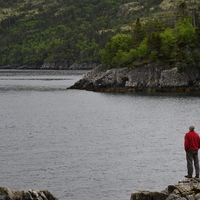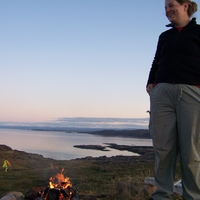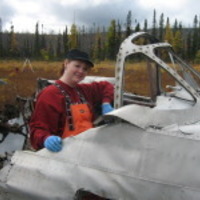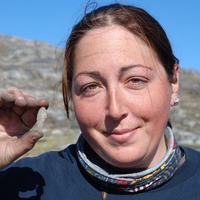
M. Stopp
My degrees are in archaeology (B.A., Wilfrid Laurier U.; M.A., Memorial U.; M.Phil., Cantab.; Ph.D., Cantab.). Earliest fieldwork was on St. Lawrence Iroquoian, Palaeoindian, and Huronia Iroquoian sites in Ontario. This was followed by a move to Newfoundland and Labrador and a decade of fieldwork and research that included working on the land and underwater sites at Red Bay National Historic site, followed by extensive coastal surveys of the Labrador side of the Strait of Belle Isle as well as western Notre Dame Bay, work at Port au Choix National Historic site, at sites along the Quebec North Shore, on Newfoundland's Avalon peninsula, and elsewhere. M.Phil and doctoral research that began in the late 1980s shifted my focus to taphonomy, examining Lower and Middle Pleistocene European faunal collections, comparing these to palaeontological deposits such as those from Old Crow, and querying whether the European archaeological collections were in fact the result of human activity (several were not). A return to Canada led to decades of CRM fieldwork, mainly in Labrador, as well as historical, ethnohistorical, oral history, and public history research. In 2022, I retired after 15 years as an historian at Parks Canada that included interesting secondments to archaeology and history projects in Labrador and on the island of Newfoundland as well as eight years as Parks Canada's delegate on the Geographical Names Board of Canada. My research has focused on cultural history of the far Northeast, forager food storage systems and mobility, cultural contacts, complex systems that underpin long-term cultural persistence, 16th-18th century Labrador Inuit-European engagement, the iconography of Inuit contact dynamics and centering Inuit performance, among others. I have worked with a number of fine researchers and colleagues over the years and an enduring pleasure has been, and continues to be, supporting their research through conversation and review.
less
Related Authors
Lisa Rankin
Memorial University of Newfoundland
Donald H Holly
Eastern Illinois University
John C Erwin
University of Calgary
Anne Hamilton
Archaeological Services Unit, Province of New Brunswick
Robert Park
University of Waterloo
Lisa M Daly
Memorial University of Newfoundland
Dominique Lavers
Memorial University of Newfoundland
InterestsView All (22)









Uploads
Books by M. Stopp
Cartwright wrote The Labrador Companion following his experiences operating a series of merchant stations in southern Labrador between 1770 and 1786. Although his focus is firmly on instruction in the manifold ways of capturing animals, he also provides rare glimpses of Innu and Inuit life as well as of housekeeping and gardening. and a lengthy description of Labrador’s fauna - of land, sea, and air.
The earliest evidence of Homo sapiens in the northern hemisphere, both during the Palaeoindian period in North America and during the Lower and Middle Pleistocene in Europe, is in the form of stone tools that are occasionally found in association with animal remains. Current models of early human adaptation in the northern hemisphere are based on a nearly unexamined assumption of cultural association between lithics and faunal remains. This research examines the methodological and theoretical nature of the interpretive links between open-air assemblages and the resultant models of human adaptation. It presents a methodological approach for assessing early-site taphonomic conditions including fluvial experimentation. It compares archaeological and palaeontological assemblages to test for discernible differences between natural versus cultural accumulations. The research highlights the probability that many early lithic/faunal associations are the result of taphonomic forces at work, not cultural, and that models of human adaptation focused on large-mammal hunting require revision.
Papers by M. Stopp
Traces in the archival and archaeological records of the 16th to late 18th century show that Labrador Inuit were engaged in a long-term struggle for place in southeastern Labrador, Canada. This examination of Inuit resistance and dispossession moves the historical narrative away from European actions and artifacts. Centering on Inuit, it reveals ways in which Inuit exercised rebellion through resistance and survivance, and influenced history for more than two hundred years.
IN: Etudes/Inuit/Studies 2015, Vol. 39, no. 1. The Inuit in Southern Labrador. Editors, L. Rankin, M. Stopp, A. Crompton
This paper presents Lydia Campbell’s (1818-1905) place in the Canadian historical landscape. One of Labrador’s best known and most cherished foremothers, “Aunt Lydia” is known for her chronicles of Labrador history and life, and is held in high regard as a notable matriarch and transmitter of Labrador memories. Through her writing and through oral traditions passed down by her many descendants, Lydia Campbell has long been an iconic figure and a touchstone to Labrador’s past. In 2009, Lydia Campbell was designated a person of Canadian national historic significance.
Further information at: https://www.pc.gc.ca/apps/dfhd/page_nhs_eng.aspx?id=14192
This report looks at the potential effects of the construction and operation of the preferred route of the proposed Trans Labrador Highway from Cartwright to Happy Valley-Goose Bay on contemporary Labrador Innu land use. Contemporary Innu land use deals with the period in recent Innu history following settlement in the 1960s (i.e., 1969 to the presentday
Cartwright wrote The Labrador Companion following his experiences operating a series of merchant stations in southern Labrador between 1770 and 1786. Although his focus is firmly on instruction in the manifold ways of capturing animals, he also provides rare glimpses of Innu and Inuit life as well as of housekeeping and gardening. and a lengthy description of Labrador’s fauna - of land, sea, and air.
The earliest evidence of Homo sapiens in the northern hemisphere, both during the Palaeoindian period in North America and during the Lower and Middle Pleistocene in Europe, is in the form of stone tools that are occasionally found in association with animal remains. Current models of early human adaptation in the northern hemisphere are based on a nearly unexamined assumption of cultural association between lithics and faunal remains. This research examines the methodological and theoretical nature of the interpretive links between open-air assemblages and the resultant models of human adaptation. It presents a methodological approach for assessing early-site taphonomic conditions including fluvial experimentation. It compares archaeological and palaeontological assemblages to test for discernible differences between natural versus cultural accumulations. The research highlights the probability that many early lithic/faunal associations are the result of taphonomic forces at work, not cultural, and that models of human adaptation focused on large-mammal hunting require revision.
Traces in the archival and archaeological records of the 16th to late 18th century show that Labrador Inuit were engaged in a long-term struggle for place in southeastern Labrador, Canada. This examination of Inuit resistance and dispossession moves the historical narrative away from European actions and artifacts. Centering on Inuit, it reveals ways in which Inuit exercised rebellion through resistance and survivance, and influenced history for more than two hundred years.
IN: Etudes/Inuit/Studies 2015, Vol. 39, no. 1. The Inuit in Southern Labrador. Editors, L. Rankin, M. Stopp, A. Crompton
This paper presents Lydia Campbell’s (1818-1905) place in the Canadian historical landscape. One of Labrador’s best known and most cherished foremothers, “Aunt Lydia” is known for her chronicles of Labrador history and life, and is held in high regard as a notable matriarch and transmitter of Labrador memories. Through her writing and through oral traditions passed down by her many descendants, Lydia Campbell has long been an iconic figure and a touchstone to Labrador’s past. In 2009, Lydia Campbell was designated a person of Canadian national historic significance.
Further information at: https://www.pc.gc.ca/apps/dfhd/page_nhs_eng.aspx?id=14192
This report looks at the potential effects of the construction and operation of the preferred route of the proposed Trans Labrador Highway from Cartwright to Happy Valley-Goose Bay on contemporary Labrador Innu land use. Contemporary Innu land use deals with the period in recent Innu history following settlement in the 1960s (i.e., 1969 to the presentday
Webpage of publications related to Labrador research, and results of some analysis and artifact photos.